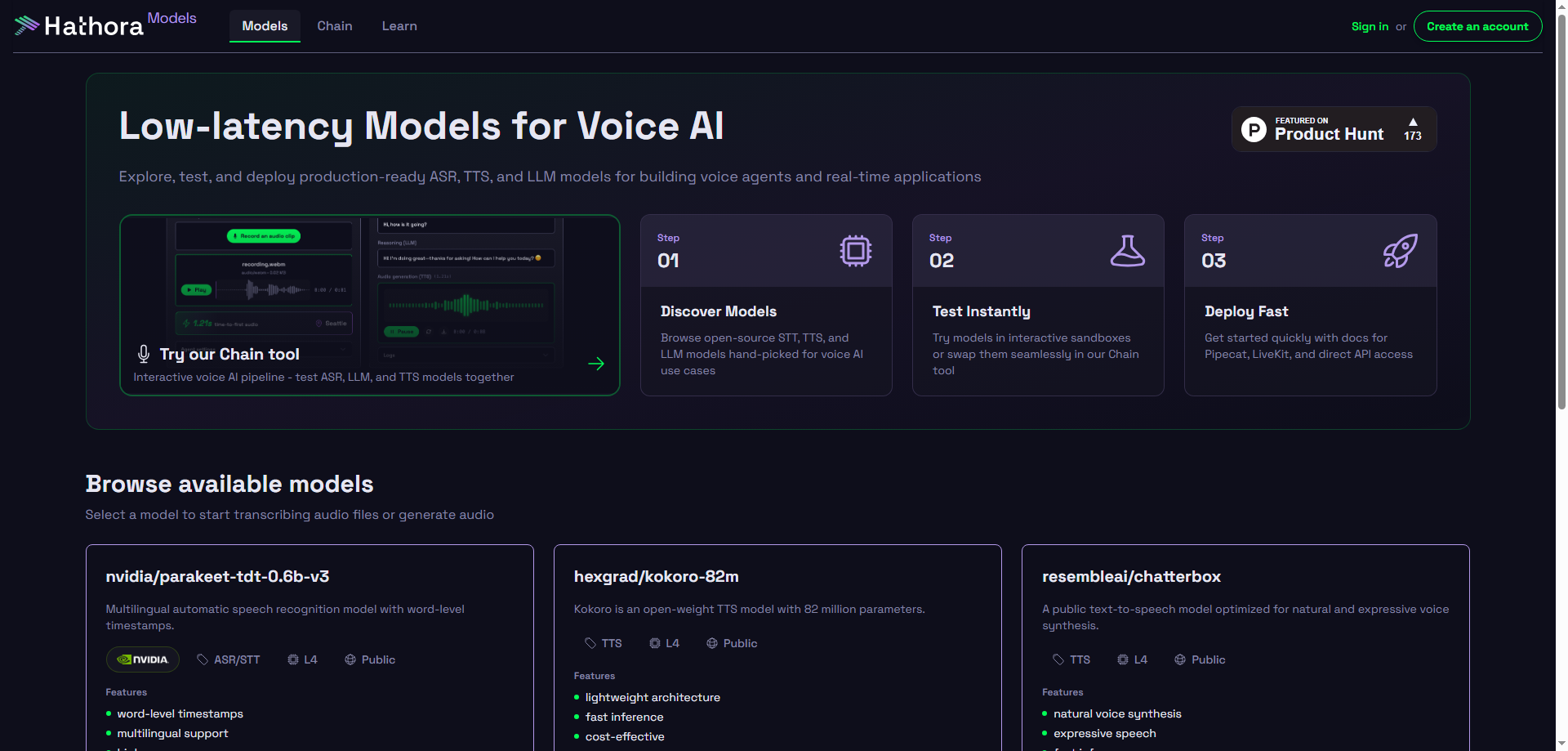1. Creative Perspective: Unlocking Possibilities with Hathora
As someone who's always looking for creative ways to bring new ideas to life, Hathora has caught my attention for its sheer simplicity and flexibility. The platform is designed to transform any voice AI model—whether open-source or proprietary—into a fully functional voice assistant without the need for complex DevOps or server maintenance. Think of it like a magic box: you just drop in your voice model, and the system handles the rest, giving you a voice assistant ready to roll.
What's really exciting is that Hathora doesn't limit you to a specific model or infrastructure. It allows you to choose from a wide range of voice models and scale effortlessly. Whether you’re creating a virtual assistant for a startup, or building a custom AI model for a niche project, Hathora gives you the creative freedom to experiment and grow.
For me, this opens up a whole new world of possibilities. Developers and creators can focus more on enhancing user experience and adding unique features instead of being bogged down by infrastructure concerns. And since it’s all deployed across 14 regions globally, you’re guaranteed an experience that’s fast and smooth—essential for engaging voice interactions.
2. Disruption: Can Hathora Replace Current Voice AI Solutions?
When I first explored Hathora, one question kept popping into my mind: Can this platform replace traditional voice AI deployment methods? The answer seems to be a resounding "Yes!" Hathora's no-fuss, plug-and-play approach to voice assistant deployment makes it an attractive alternative to other solutions that demand significant infrastructure management and technical expertise.
Many current voice AI platforms require developers to dive deep into DevOps, manage servers, and often deal with bottlenecks in scaling. Hathora eliminates all of that. By abstracting the complexity of server management and providing flexible, low-latency deployment across multiple regions, it simplifies what was once a daunting task.
What’s also compelling is Hathora’s ability to support both open-source and closed-source models. This means businesses no longer have to settle for a generic, off-the-shelf voice model if they have specific needs or want to differentiate themselves in the market. Whether you're developing a chatbot, a customer support assistant, or an interactive voice response (IVR) system, Hathora offers a robust alternative to conventional voice AI solutions.
3. Addressing Real-World Needs: Will Users Embrace Hathora?
Looking at the practical side, Hathora fills a gap that many users have been waiting for: an easy-to-use platform that lets them create custom voice assistants without the complexity of traditional systems. I can easily see why this would be appealing to startups, independent developers, and businesses that need quick solutions but don’t have the luxury of hiring a whole DevOps team.
For example, small businesses and developers can rapidly deploy voice assistants for customer service, which would otherwise be time-consuming and expensive. Additionally, enterprises dealing with sensitive data can benefit from the ability to deploy assistants in private environments, ensuring data security and compliance.
The real question is: how will Hathora be received by the broader market? Given that it reduces barriers for entry and increases deployment speed, it’s likely to find a solid user base. However, for businesses with already established AI systems, migrating to Hathora may seem unnecessary unless they specifically need its flexibility or have scaling issues.
4. The Future: Risk, Rewards, and Evaluation
If I had to rate Hathora on its potential to survive and thrive in the next year, I’d give it a solid 4 stars. Here's why:
Opportunities:
- Expanding User Base: There is clear potential for growth in markets like e-commerce, customer service, and even gaming, where AI-driven voice interactions are becoming increasingly important. The ability to integrate voice assistants quickly will attract many businesses looking to enhance user engagement.
- Customization and Flexibility: With its ability to support custom models and containers, Hathora is also positioning itself as an appealing choice for more advanced users who need flexibility without the hassle of traditional infrastructure.
Risks:
- Competition: Hathora faces stiff competition from established voice AI platforms like Amazon Alexa for Business, Google Cloud AI, and Microsoft Azure. These competitors offer robust ecosystems and can provide more out-of-the-box integrations, which may draw users who don’t want to worry about building everything from scratch.
- Market Adoption: While the concept of a no-code, hassle-free voice assistant platform is appealing, the real challenge will be convincing businesses to shift from traditional platforms to Hathora. The platform will need to prove that its approach is as reliable and scalable as current, more entrenched options.
- Reliability and Scaling: As Hathora grows and attracts more users, maintaining the performance and low latency in multiple regions will be critical. If the platform can continue to scale smoothly, it will be in a great position to capture a larger market share.
Conclusion:
Hathora is well-positioned for success if it can continue to capitalize on the simplicity and flexibility it offers. However, it needs to stay ahead of the competition and ensure that scaling and reliability remain top priorities as the user base expands. If it can achieve this, Hathora could very well become a go-to platform for AI voice assistant deployment in the coming year.
In the end, it’s all about giving users a seamless, low-cost, and flexible solution—and Hathora is definitely doing that.









